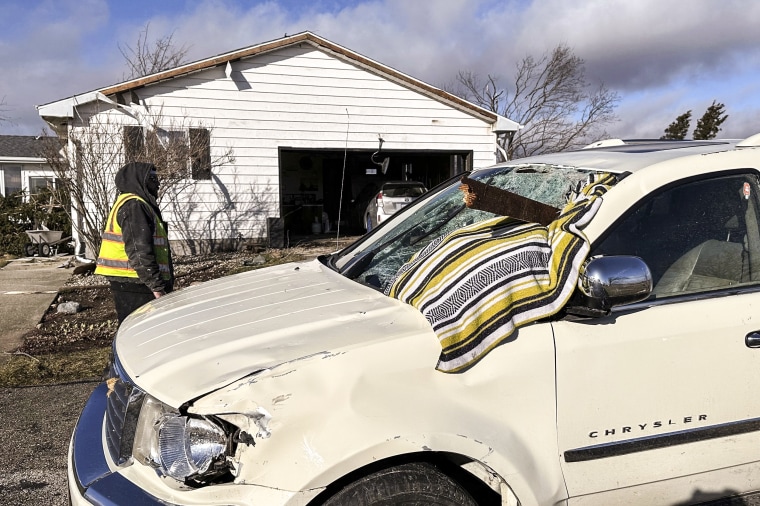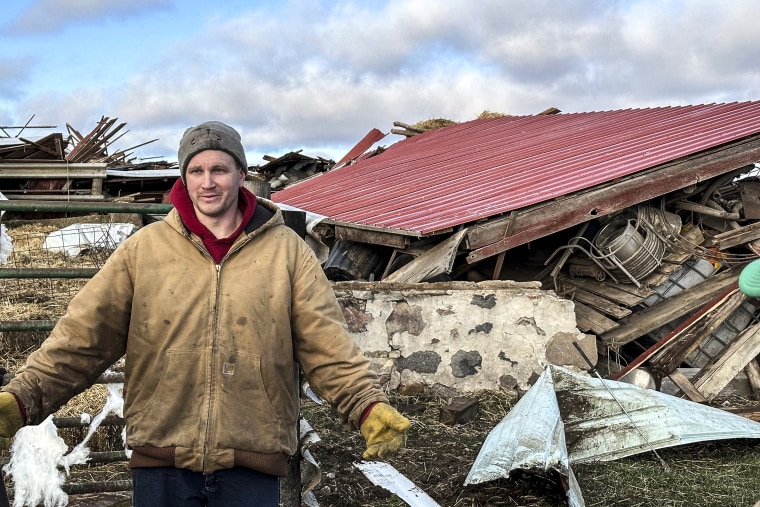A rare winter tornado churned through southern Wisconsin on Thursday, snapping power poles, downing large trees and damaging homes.
It was the state’s first recorded tornado in the month of February, according to Taylor Patterson, a meteorologist at the National Weather Service in Milwaukee. Records date back to 1948.
“This is a very unusual time of year for Wisconsin to be getting tornadoes,” Patterson said. “We were also unusually warm yesterday.”
Several thunderstorms also traveled across Iowa and Illinois on Thursday, dropping hailstones that ranged from the size of peas to the size of ping pong balls. A tornado developed in northern Illinois during this extreme weather event, too.
High temperatures were about 25 degrees Fahrenheit warmer than usual on Thursday in parts of Wisconsin. More research would be needed to connect this rare, winter tornado to climate change, but scientists expect warmer temperatures, more frequent severe weather and more intense severe weather as a result of carbon pollution raising global temperatures.
“There is no clear way to say if climate change contributed, but that’s something we would have to do more research on,” Patterson.
Temperatures were so warm on Thursday that they touched or broke records from 1925. The mercury topped out at 59 degrees F in Madison and 59 in Milwaukee.
A strong El Niño pattern is likely contributing to chart-topping temperatures.

“When there’s a strong El Niño signal, we are warmer than normal, which we have seen throughout this winter,” Patterson said. “We have broken multiple high temperature records and high minimum temperatures as well.”
Patterson said there were damage reports in Evansville, Edgerton and Albany, which are rural communities south of Madison.
No major injuries were reported, Patterson said.
It wasn’t immediately clear if all the damage was from a single tornado or if multiple twisters had struck in Wisconsin. Patterson said National Weather Service crews visited damage sites on Friday to assess and classify the strength of the tornado on the Enhanced Fujita Scale.
“The tornado track near Evansville to SW Jefferson Co is a high end EF2,” the weather service said in an X post Friday afternoon.
Scott Lindstrom, a scientist at the University of Wisconsin-Madison Cooperative Institute for Meteorological Satellite Studies, said it was the strongest tornado in Wisconsin since August 2021 and that it had a relatively long track.
Lindstrom said the event was unusual because a clear sky preceded the twister, which developed just after sundown.
Wisconsin has seen winter tornadoes before, including three in January.

Warming temperatures are shifting the risk of supercell thunderstorms, tornadoes and the timing of these events, and scientists are trying to understand how that will play out. A study published last year in the Bulletin of the American Meteorological Society found that the risk of supercell storms would increase as global temperatures warmed. These storms would likely become more numerous in the eastern United States, but decrease in the Great Plains.
The study said the incidence of supercell storms “and their perils” would likely increase in late winter and early spring but decrease in late summer and fall as climate change advances.
“These results suggest the potential for more significant tornadoes, hail, and extreme rainfall that, when combined with an increasingly vulnerable society, may produce disastrous consequences,” the authors wrote.










